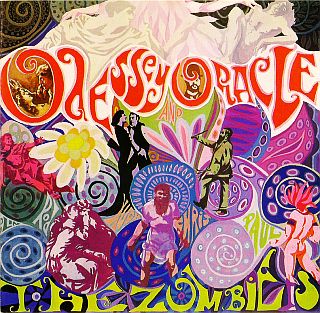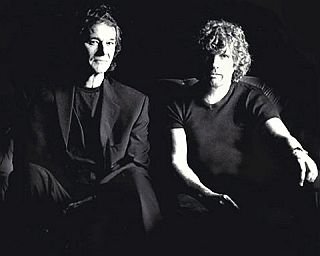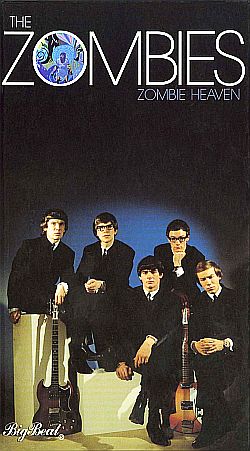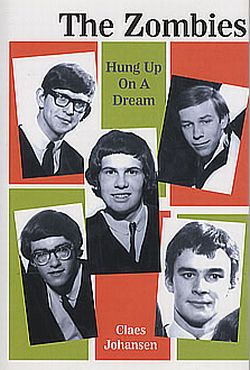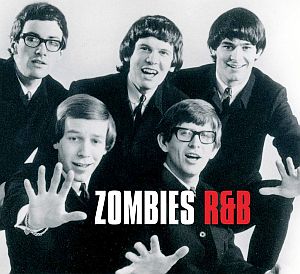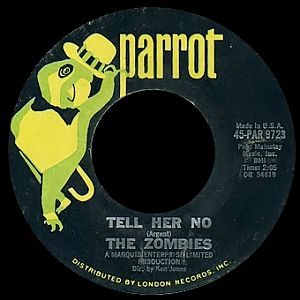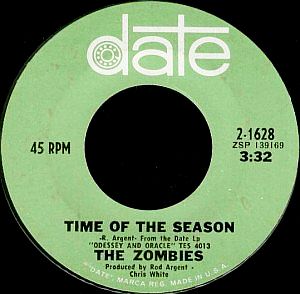
Keira Knightley in an early frame of 2014 Chanel ad.
Music Player
“She’s Not There”-The Zombies
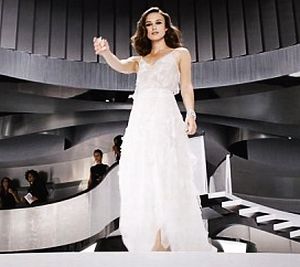 Holding out a bottle of her perfume, she beckons Danila, the man who has spotted her from below. |
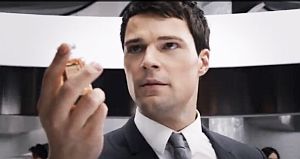 Danila catches her perfume bottle, but she has moved... |
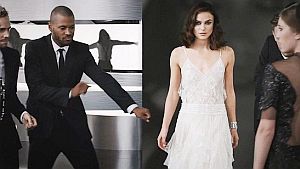 ...She’s joined the party, as Danila walks toward her... |
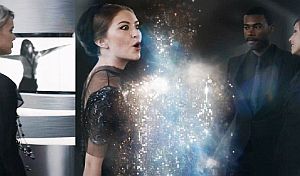 ...But then she vanishes as their paths are crossed... |
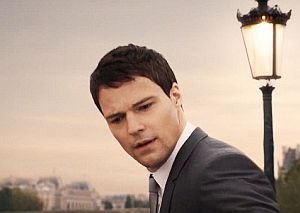 Next day. Danila on a river bridge, sees a boat below... |
 ..”It’s that Coco dame from the party last night”... |
 Bringing her boat to a swirling turn, she glances back up at the man she left enchanted the previous evening... |
“She’s Not There” was a top hit in the U.S., the U.K., and elsewhere 50 years ago. Still, in the Chanel TV spot, the Zombies’ sound is crisp and clear, the vocals airy and enticing, and the lyrics aptly suited to Ms. Knightley as she glides through the frames.
“She’s Not There” is also one of those songs that will catch the ear of those from an earlier time who unexpectedly hear it and are pleasantly astonished at its quality, reminded once again how good the music was from those years.
The new Coco Mademoiselle perfume ad, explains Chanel’s promo, “reveals Keira Knightley, full of mystery and fascination,” a woman “with a unique and carefree style.” In fact, she is cast as something of a high-class tease, being elusive and alluring as she enters a party setting, playing with her quarry, Russian actor Danila Kozlovsky. And the Zombies’ music helps set the stage:
Well no one told me about her;
The way she lied…
Well no one told me about her;
How many people cried.
The ad races by in 30 or 60 seconds, depending on the cut – as all things commercial these days go by faster and faster it seems, no thanks to quick-cut advertising. Nevertheless, the imagery in this ad works reasonably well, as a sampling of screenshots at right offer a look at some of the ad’s visuals and storyline.
Knightley, in a sexy white gown, is seen lounging early on in the ad, silhouetted behind a glass screen applying a drop of the magic potion. She then makes an appearance on a central staircase, catching the eye of her leading man, Danila, who is mesmerized by her beauty, gazing up at the staircase.
Knightley, whose recent film credits include Pride & Prejudice, Atonement, and Anna Karenina, has been the face of Chanel since 2007, starring as founder Coco Chanel in earlier spots. In this newest role, she is cast as the elusive and mysterious Coco, who typically lures the best-looking man in the house and then vanishes – or as the Zombies put it, “she’s not there.”
Descending the staircase into the cocktail party, she teases her new mark, holding out a bottle of Coco Mademoiselle Chanel perfume, which she drops as Danila lunges to retrieve it.
In the next frame, as Danila looks up to see her, she is gone, now on the other side of the room. As he strides across the room to meet her, another party guest crosses his path, and in a burst of cosmic sparkle, Keira vanishes. Again, the Zombie refrain:
Please don’t bother trying to find her;
She’s not there.
Cut to the next day, as Danila is walking across a bridge talking on his mobile phone when he spies the casually-attired Keira piloting a speedboat on the river below. As she passes beneath the bridge, he runs to other side to catch another look at her.
Making a turn with her boat on the other side of the bridge, she glances back up at him – the man she left bedazzled and wanting at the party the previous evening.
The camera then cuts to a final close-up of Kiera’s beautiful face and inquiring brown eyes, as the Zombies add their final lyrics — no doubt with a sequel to come.
Let me tell you ’bout
the way she looked,
The way she acted, the color of hair;
Her voice was soft and cool;
Her eyes were clear and bright;
But she’s not there.
In the U.S., the ad ran in primetime, during shows such as Once Upon A Time, Blacklist, Parenthood, and others, and sometimes there was an “available at Macy’s” or other retail tag at the ad’s end, along with a concluding shot of the Coco Mademoiselle perfume bottle.
At the Chanel.com website, the perfume is described as “daring and bold, yet sensual and elegant….Inspired by the irrepressible spirit of the young Coco Chanel, the modern Oriental fragrance entices with an utterly feminine composition, expressing refined sensuality and incredible freshness.” The website also includes the video of the TV ad.
The entire mini production, as a piece of commercial persuasion designed mostly for female viewers, is nicely done, and the Zombies’ tune helps to make it work. What follows below is more about the Zombies, their music, and their history.
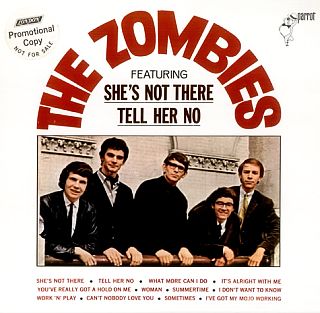
Cover for the 1965 vinyl U.S. album featuring The Zombies’ hit songs, “She’s Not There” & “Tell Her No.” Click for CD.
The Zombies
The Zombies formed in 1962 from a group of young musicians in St. Albans, England. Paul Atkinson, Rod Argent, and Hugh Grundy met at St. Albans School, and they soon linked up with Colin Blunstone and bassist Paul Arnold, although Arnold would be replaced by Chris White six months later.
After winning a music competition sponsored by the London Evening News, they signed with Decca records in 1964 and soon scored their first hit song, “She’s Not There.”
The song was written by Rod Argent, only his second at that point, written for the group’s Decca recording session on June 12th, 1964 at Decca’s West Hampstead Studio. It was one of four songs recorded by the Zombies at that session.
The Zombies’ lineup then included Argent on keyboard and vocals, Paul Atkinson on guitar and vocals, Chris White on bass and vocals, Hugh Grundy on drums, and Colin Blunstone singing lead vocals.
“She’s Not There,” an electric-piano based tune, with Blunstone’s lead vocals, was released in July 1964. “This minor-key, jazz-tinged number, distinguished by its musicianship and Blunstone’s breathy vocal,” said Rolling Stone, “was unlike anything heard in British rock at the time.” The song peaked at No. 12 on the U.K. charts and would become the group’s only Top 40 U.K. hit.
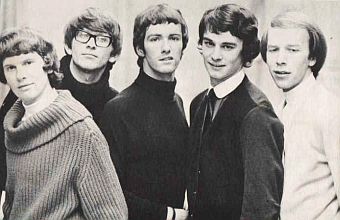
1960s: The young Zombies (l to r): Rod Argent, Chris White, Paul Atkinson, Colin Blunstone, Hugh Grundy.
…In 1964 a practically unknown British beat group calling themselves The Zombies released a single on Decca Records bearing the title “She’s Not There.” Incredibly dynamic and built on driving, jazzy bass line over which drums, electric piano and voice were forming individual rhythms and pattern almost like in a piece of Baroque chamber music, this unusual record gave a glimpse of a future where musical styles could be merged freely and without prejudice. It was very much of its time, a charming little slice of pop vynil, easy to take, hard to let go…
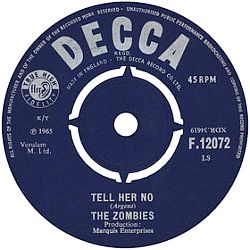
Decca-issued 45 rpm for Zombies’ 1965 hit, “Tell Her No”-- rose to No. 6 in the U.S. Click for digital.
Music Player
“Tell Her No”- The Zombies
Throughout 1965 and into 1966, the Zombies toured America and Europe. In 1965, they also became involved with the British film Bunny Lake Is Missing, a psychological thriller starring Laurence Olivier, directed and produced by Otto Preminger. The Zombies were featured on the film’s poster for three songs they did for the soundtrack: “Remember You”, “Just Out of Reach” and “Nothing’s Changed.” They also appeared in the film, prominently featured performing on television in a pub scene. They also recorded a two-minute radio ad set to the tune of “Just Out of Reach” to promote the film’s release. However, in 1966, no big, fresh hits came their way. By early 1967, at a time when their record career had almost ground to a halt in the UK, the Zombies played to crowds of over 30,000 in the Philippines. Yet, at that point, the group appeared to be at a crossroads of sorts.
With their Decca recording contract about to expire, the group decided that they would make a final album before calling it quits. In the spring of 1967, they signed with CBS Records to produce a studio album, only the second of their career. From these sessions would come the album Odessey and Oracle. They produced the music themselves on a shoestring budget.They began working on the album in June 1967, and nine of the twelve songs were recorded at EMI’s Abbey Road Studios. In August, when the Abbey Road studio became unavailable, they moved to Olympic Studios where three more songs were recorded. The following month they returned to Abbey Road, finishing in November with the album’s final track.
Along the way, and during some of the sessions, there had been a few testy exchanges among band members. By the end of the sessions, morale was at a low point. Two Zombies’ singles at the time had also been unsuccessful, and demand for their live appearances had declined. After a final stage performance in mid-December 1967, the band split up.
The album they produced for CBS, meanwhile, languished. Only after U.S. CBS staff producer Al Kooper fought to have it issued, was it released.“Without Al,” explained Rod Argent some years later in a DigBoston.com interview, Odessey and Oracle “wouldn’t have been known by anybody. He took it to Clive Davis and said, ‘Whoever’s got this album, you’ve got to buy it and release it.’
“Clive Davis said, ‘Well we’ve got it, but we passed on it already.’ Al said, ‘Well you can’t. You have to put it out.’ So he had everything to do with that album coming out.” Kooper, having picked up an early copy of the album during a trip to London, loved it and believed it contained a few hit singles. CBS/Columbia released it in April 1968 on a subsidiary label, Date Records.
Odessey and Oracle did not have soaring sales initially, but Kooper’s belief about some of the songs as singles was right on the money. CBS chose the song “Butcher’s Tale” as the first single to release in the States, feeling the song’s anti-war theme (based on World War I) would resonate with record-buyers due to the Vietnam War. However, it was another song that really hit paydirt – “Time of the Season.” The song was written by Rod Argent and recorded by the Zombies at Abbey Road in August of 1967. It was also released as a single with the album in April 1968, but did not receive much attention at the time.
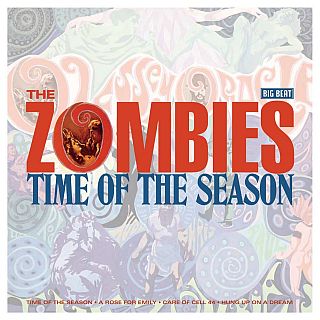
Big Beat’s 2010 EP special featuring Zombies’ “Time of Season” & others. Click for digital version of 'Time of the Season'.
Music Player
The Zombies – “Time of The Season”
By February 1969 “Time of the Season” entered the U.S. Top 40, and in March rose to No. 3 on the Billboard pop chart. It also became a million seller, remaining in the Top 40 for eleven weeks. “Time of The Season” was also a No. 1 hit in Canada in March 1969.
With the success of “Time of the Season,” the band was urged to reform – and they were offered sizeable sums of money to do so, but they refused. Some of them were fed up with the music business and began other pursuits. Rod Argent was then moving ahead with plans for a another band he and others would form, called Argent. He would be joined there by Chris White, who came on as a non-performing songwriter. One of Argent’s hit songs, “Hold Your Head Up,” was written by Argent and White. Blunstone at first went back to work in insurance, but then returned to singing, putting out several LPs in the 1970s on his own, forming a group called Keats, and also singing with the Alan Parsons Project. Atkinson went into computer programming initially, but later did A&R work (Artists & Repertoire), first for Columbia in New York and later as a v. p. for A&R at RCA’s West Coast office. [“A&R” is the division of a record label or music publishing company that is responsible for talent scouting and overseeing the artistic development of recording artists and/or songwriters. A&R people also serve as liaison between artists and record labels or publishing companies ]. Grundy also worked in Columbia’s A&R department, and in the 1980s also ran a horse transport business near London.
“I still have it indelibly framed in my mind that when we split, there was no interest in the band anywhere,” said Colin Blunstone, in a 1998 interview with New York Times pop music reporter, Neil Strauss. “That’s one of the reasons we all went our separate ways. And that stays with you. You have this feeling of not being particularly appreciated as you go off and do other things.” But time would change that.
Better With Time
The Zombies would prove to be one of those groups whose music would be belatedly discovered by some, and whose songs would grow in appreciation with time. Helping that process along has been the Big Beat record label of Ace Records in London. In late 1997, Big Beat issued Zombie Heaven, a four-CD box set that gathered up every vintage Zombies recording it could find and remastered them in one set. That set became one of the best-selling titles in the Ace Records catalogue. It even surprised some of the Zombies.
“Overall, the box set made a much better impression than I expected,” said Rod Argent to Neil Strauss of the New York Times in a 1998 review. “It’s strange, actually, because looking back on those early Zombies singles I don’t quite feel the same frustration now. Some of them sound excellent to me.” Argent also had words of praise for guitarist Chris White after listening to the box set. “In fact, I phoned him up after I listened to it and said, ‘I don’t want this to sound patronizing, Chris, but I’ve just got to tell you, your bass playing is great.’ It’s probably something I’ve never said to him before. So I said it 30 years too late.”
Neil Strauss of the Times also noted some of the Zombies’ work in his review: “Over the course of the ensuing decades, [The Zombies’] final album… Odessey and Oracle – a beautifully arranged, harmony drenched pristine pop paean to memory, the changing seasons, the passage of time and lost love – slowly began to be recognized as one of the greatest albums of the 1960s.” Others have also cited the album. In 2003, Odessey and Oracle was ranked at No. 100 on Rolling Stone’s “500 Greatest Albums of All Time.”Several other music magazines have also ranked the album on various “greatest” and/ or “best ever” albums lists – including Stylus, Mojo, NME, and Q, as well as The Guardian. Some have also compared Odessey and Oracle to the Beatles’ Revolver album and the Beach Boys’ Pet Sounds album. Music critic Richie Unterberger has offered similar kudos: “Aside from the Beatles and perhaps the Beach Boys, no mid-’60s rock group wrote melodies as gorgeous as those of the Zombies.” In addition, a variety of performing artists have also cited Odessey and Oracle as a favorite or an influence on their own work, including: Tom Petty, Dave Grohl of the Foo Fighters, Paul Weller of the punk band The Jam, and teenage UK indie band, The Vaccines. Rod Argent also belatedly discovered that Elvis Presley had Zombies singles on his personal play list, and that John Lennon wanted to produce the band. In 2001, a Zombies biography was published by Claes Johansen, Hung Up on A Dream, a title of a Zombies’ song. The book was penned with the co-operation of the five original members of the band who are interviewed extensively throughout the book.
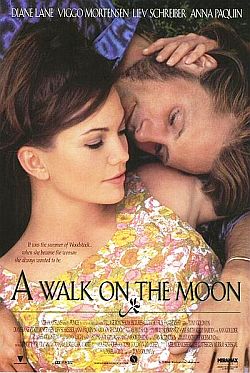
Poster for 1999 film, “A Walk on the Moon” with Diane Lane & Viggo Mortensen – “It was the summer of Woodstock when she became the woman she always wanted to be.” Click for film DVD.
The Zombies’ music has also received airing in films and TV shows. “Time of The Season” has been used in films to represent the late 1960s or 1969, the year the song became popular, as in the films: 1969 (1988), Awakening (1990), A Walk on the Moon (1999) and Riding the Bullet (2004), all of which depict the year 1969.
On TV, “Time of The Season” was featured in the third season (2004) of the NBC series American Dreams, which depicts a Philadelphia family in the mid- and late-1960s, with some focus on the American Bandstand TV dance show of that era (the series was also produced by a Dick Clark company). “Tell Her No” and “She’s Not There” were also used in the American Dreams series.
Other TV shows that have used “Time of the Season” in various episodes include: Tour of Duty (1987-1990), the HBO series Big Love, Friends(in 1996), the NBC miniseries The ’60s (1999), and Will and Grace (in 2002). The song is also used in a few video games.
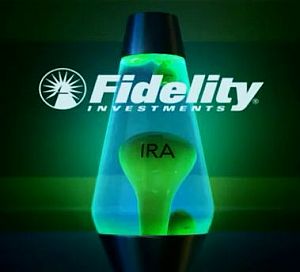
A 2005 Fidelity Investments TV ad used “Time of the Season” with its pitch. Click to view ad on YouTube.
In 2006, “Time of the Season” was also used in a U.K. ad for Bulmers Irish Cider. That ad was part of themed series following the changing seasons. “Spring II” depicted an apple orchard coming back to life in the spring with a segue to the rising social life in pubs and bars. The ad appeared on ITV, Channel Four and Five throughout the U.K. In America, during the 2006 Major League baseball playoffs, the song was played in Shea Stadium as the home-team New York Mets took the field.
The 2014 Keira Knightley TV spot for Chanel’s Coco Mademoiselle perfume presented at the top of this article will likely bring new listeners to the music of the Zombies – music that is now 50 years young and counting! For additional stories at this website on music and/or advertising, please see the Annals of Music category page or the Madison Avenue page. Thanks for visiting – and if you like what you find here, please make a donation to help support the research and writing at this website. Thank you. – Jack Doyle
Addendum: An October 2015 interview with Rod Argent published in the Washington Post, noted that the reformed Zombies (without their late guitarist, Paul Atkinson), had begun touring to feature songs from their Odessey & Oracle album. During the interview, Argent also noted of the album: “…[T]oday it sells more than it ever did, even after ‘Time of The Season’ was a hit.”
|
Please Support Thank You |
____________________________________
Date Posted: 31 March 2014
Last Update: 25 April 2019
Comments to: jdoyle@pophistorydig.com
Article Citation:
Jack Doyle, “Keira & The Zombies: 2014 & The 1960s,”
PopHistoryDig.com, March 31, 2014.
____________________________________
Sources, Links & Additional Information
“Coco Mademoiselle: Feminine and Sexy, Young and Exciting,” Chanel.com, Accessed, March 29, 2014.
Katy Winter, “Keira Knightley Is Breath-taking in New Coco Mademoiselle Advert..,” Daily Mail (London), March 18, 2014.
Leanne Bayley, “Watch: New Coco Chanel Advert Starring Keira Knightley, Glamour Magazine.co.uk, Tuesday, March 18, 2014.
Emma Bazilian, “Ad of the Day: Keira Knightley Does Her Best Bond Girl Imitation for Chanel;Joe Wright Directs ‘She’s Not There’,” AdWeek.com, March 26, 2014.
“The Zombies,” in Holly George-Warren and Patricia Romanowski (eds), The Rolling Stone Encyclopedia of Rock & Roll, New York: Rolling Stone Press, 3rd Edition, 2001, pp. 1107-1108.
“The Zombies,” AceRecords.co.uk.
Neil Strauss, “The Pop Life; A New Season For the Zombies,” New York Times, January 28, 1998.
Neil Strauss, “The Pop Life; Desperately Seeking Synergy,” New York Times, May 31, 2001.
“The Zombies,” Wikipedia.org.
Review of Claes Johansen book, “The Zombies: Hung Up On A Dream A Biography 1962-1967,” Psychedelic-RocknRoll.Blogspot- .com, January 2012.
“She’s Not There,” Wikipedia.org.
Jole Whitburn, The Billboard Book of Top 40 Hits, 8th Edition, New York: Billboard Books, p. 697.
Fred Bronson, “The Top 100 Songs of 1964,” Billboard’s Hottest Hot 100 Hits, 4th edition, New York: Billboard Books, 2007, p. 354. (“She’s Not There,” No. 30 ).
Fred Bronson, “The Top 100 Songs of 1969,” Billboard’s Hottest Hot 100 Hits, 4th edition, New York: Billboard Books, 2007, p. 370. (“Time of the Season,” No. 39 ).
“Odessey and Oracle,” Wikipedia.org.
Blake Maddux, “Interview: Rod Argent of the Zombies,” DigBoston.com, July 5, 2013.
“Time of the Season,” Wikipedia.org.
“Bunny Lake Is Missing” (1965 film),Wikipe- dia.org.
Jack Doyle, “Early Beach Boys, 1962-1966,” PopHistoryDig.com, June 14, 2010.
Jack Doyle, “Beatles History: 12 Stories,” (topics page listing 12 Beatles stories w/thumbnails & links) PopHistoryDig.com, December 15, 2011.
Roger Catlin, “The Zombies Resurrect Their Famous Album,” WashingtonPost.com, October 2, 2015.
_______________________________________________________________
